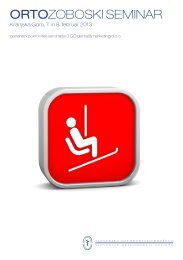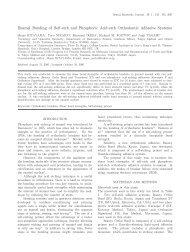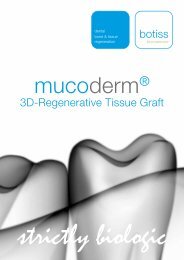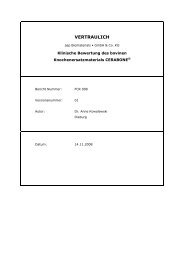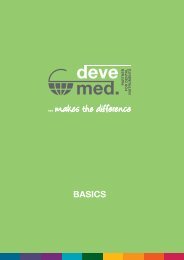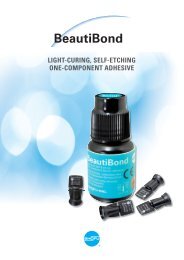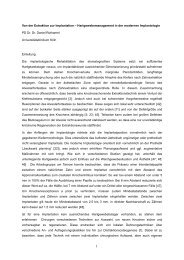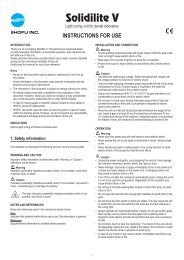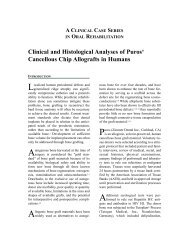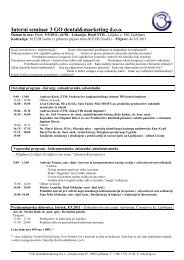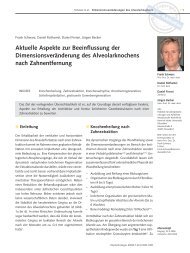Duraplasty: Our Current Experience - 3 go / dental&marketing
Duraplasty: Our Current Experience - 3 go / dental&marketing
Duraplasty: Our Current Experience - 3 go / dental&marketing
You also want an ePaper? Increase the reach of your titles
YUMPU automatically turns print PDFs into web optimized ePapers that Google loves.
<strong>Duraplasty</strong> Surg Neurol<br />
2004;61:55–9<br />
33. Ng TH, Chan KH, Leung S, et al. An unusual complication<br />
of silastic dural substitute: case report. Neurosurgery<br />
1990;27:491–3.<br />
34. Ohbayashi N, Inagawa T, Katoh Y, et al. Complications<br />
of silastic dural substitute 20 years after dural<br />
plasty. Surg Neurol 1994;41:338–41.<br />
35. Ongkiko CM, Keller JT, Mayfield FH, et al. An unusual<br />
complication of Dura Film as a dural substitute. Report<br />
of two cases. J Neurosurg 1984;60:1076–9.<br />
36. Parizek J, Mericka P, Spacek J, Nemecek S, Elias P,<br />
Sercl M. Xenogenic pericardium as a dural substitute<br />
in reconstruction of suboccipital dura mater in children.<br />
J Neurosurg 1989;70:905–9.<br />
37. Penfield W£G. Menin<strong>go</strong>cerebral adhesions. A histological<br />
study of the results of cerebral incision and<br />
cranioplasty. Surg Gynecol Obstet 1924;39:803–10.<br />
38. Robertson RCL, Peacher WG. The use of tantalum foil<br />
in the subdural space. J Neurosurg 1948;2:281–4.<br />
39. Rosomoff HL. Ethilene oxide sterilized freeze-dried<br />
dura mater for the repair of pachymeningeal defects.<br />
J Neurosurg 1959;16:197–208.<br />
40. Sharkey PC, Usher FC, Robertson RCL, Pollard C. Lyophilized<br />
human dura mater as a dural substitute.<br />
J Neurosurg 1958;15:192–8.<br />
41. Simpson D, Robson A. Recurrent subarachnoid bleeding<br />
in association with dural substitute. J Neurosurg<br />
1984;60:408–9.<br />
42. Thadani V, Penar PL, Partington J, et al. Creutzfeldt-<br />
Jacob disease probably acquired from a cadaveric<br />
dura mater graft: case report. J Neurosurg 1988;69:<br />
766–9.<br />
43. Thammavaran KV, Benzel EC, Kesterson L. Fascia lata<br />
graft as a dural substitute in neurosurgery. South<br />
Med J 1990;83:634–6.<br />
44. Thompson DN, Taylor WF, Hayward RD. Silastic dural<br />
substitute: experience of its use in spinal and foramen<br />
magnum surgery. Br J Neurosurg 1994;8:157–67.<br />
45. Thompson D, Taylor W, Hayward R. Haemorrhage<br />
associated with silastic dural substitute. J Neurol<br />
Neurosurg Psychiatry 1994;57:646–8.<br />
46. Van Calenberg F, Quintens E, Sciot R, Van Loon J,<br />
Goffin J, Plets C. The use of Vicryl as a dura substitute:<br />
a clinical review of 78 surgical cases. Acta Neurochir<br />
(Wien) 1997;139:120–3.<br />
47. Verheggen R, Schulte-Baumann WJ, Hahm G, Lang J,<br />
Freudenthaler S, Schaake Th, Markakis E. A new technique<br />
of dural closure: experience with a Vicryl mesh.<br />
Acta Neurochir (Wien) 1997;139:1074–9.<br />
48. Yamada S, Goto K, Oda Y, Kikuchi H. Clinical experience<br />
with expanded polytetrafluoroethyene sheet<br />
used as an artificial dura mater. Neurol Med Chir<br />
(Tokyo) 1993;33:582–5.<br />
49. Yamada K, Miyamoto S, Nagata I, Kikuchi H, Ikada Y,<br />
Iwata H, Yamamoto K. Development of a dural substitute<br />
from synthetic bioabsorbable polymers. J Neurosurg<br />
1997;86:1012–7.<br />
59<br />
50. Yamada K, Miyamoto S, Takayama M, Nagata I, Hashimoto<br />
N, Ikada Y, Kikuchi H. Clinical application of a<br />
new bioasorbable artificial dura mater. J Neurosurg<br />
2002;96:731–5.<br />
COMMENTARY<br />
Caroli et al have presented their massive experience<br />
with Tutoplast pericardial and dural implants<br />
in circumstances where autolo<strong>go</strong>us dural substitute<br />
is unavailable, insufficient, or inconvenient.<br />
Their overall results are excellent, and their rare<br />
complications are well reported. Their rationale for<br />
switching from dura to pericardium is reasonable,<br />
despite their previous excellent results.<br />
My only quibble with the authors is the undocumented<br />
assertion in the first sentence of their introduction<br />
that “it is imperative to provide a complete<br />
and watertight dural closure. . .” This<br />
statement places them at one far end of what is<br />
clearly a spectrum of practice, which, at its other<br />
end, includes the plication open of suboccipital decompressions<br />
for Chiari malformations. With the<br />
exception of large defects with underlying denuded<br />
cortex, my routine practice for small defects has<br />
been the placement of gelfoam, and the specifically<br />
nonwatertight Durogen has also proved satisfactory<br />
in our institution. I have long doubted the<br />
possibility of watertight closure without formal<br />
obeisance to the coagulation cascade, which I believe<br />
to be the final arbiter of fistula formation. It is<br />
of interest that in their two cases involving subacute<br />
reoperation, there had been complete reabsorbtion<br />
of the Tutoplast dura and pericardium,<br />
respectively. Perhaps, as suggested, this is only a<br />
reflection of the underlying secondary infections,<br />
but perhaps the closures are not able to maintain<br />
their watertight character as well as might be<br />
thought. All this said, I applaud the efforts of the<br />
authors to prevent scar bridging and CSF fistulae,<br />
am impressed by their results, and appreciate the<br />
sharing of their experience.<br />
C. David Hunt, M.D.<br />
Department of Neurological Surgery<br />
New Jersey Medical School<br />
Newark, New Jersey



